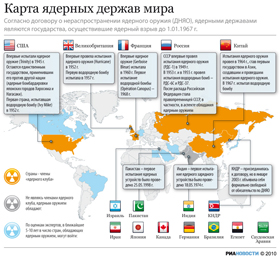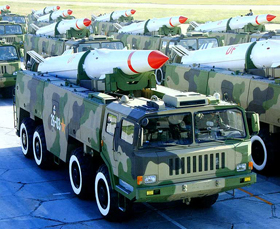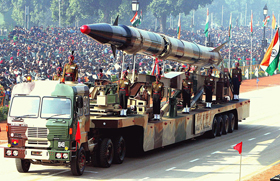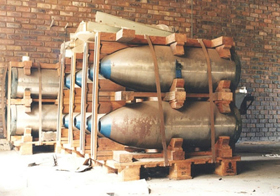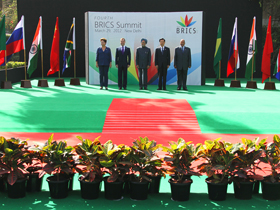The agenda pursued by the young but influential group of countries known as BRICS (Brazil, Russia, India, China and South Africa) includes a variety of nuclear and related issues in international affairs. The strengthened non-proliferation regime, which promotes compliance with the provisions of the Nuclear Non-Proliferation Treaty (NPT) and other agreements in that area, and the resulting progress toward nuclear disarmament appear an important instrument in leading the BRICS to their self-proclaimed goal of achieving a “fair and democratic world order”.
Among BRICS countries, the nuclear issue, in its condensed form, tends to focus more on public safety, at least this is how it appears from, inter alia, certain provisions of the 2011-2012 BRICS summits, referring to the “strict adherence to the construction and operation standards of nuclear power stations.” The BRICS do not have a separate nuclear “negotiations track” (as exists for the finance ministers, etc.). However, significantly, the very first joint communique by the foreign ministers of what was then four BRIC countries (in Yekaterinburg, May 2008) touched upon disarmament and non-proliferation as two mutually complementary areas in international security.
Nuclear Status and Country Approaches
Two BRICS nations, Russia and China, belong to the five official members of the world’s “nuclear club” and, as such, are NPT signatories. India is one of the four nations that, although not party to the NPT, are de facto nuclear powers. Brazil and South Africa have signed the NPT as nuclear ‘have-nots,’ but they have nuclear power or research reactors. Brazil, Russia and South Africa have ratified the Comprehensive Nuclear Test Ban Treaty (CTBT, 1996). China has signed it but not ratified it, and India, although altogether outside the CTBT framework, is one of the eight nations whose stance has so far made it impossible for the CTBT to take effect. Four BRICS countries (all except India) belong to the Nuclear Suppliers Group (NSG), set up to reinforce nuclear export controls. All five BRICS participate in the Geneva Conference on Disarmament and are engaged in developing, to varying extents, civilian nuclear power projects. Russia has 33 nuclear reactors, China has 16, India 20, and Brazil and South Africa have 2 nuclear reactors each. These are the status parameters that underpin the nuclear policies of each of the five BRICS.
Absolute Leader
Russia is the absolute leader among the BRICS both in terms of civilian and military nuclear capacity. Russia is the legal successor of the Soviet Union as one of the three NPT Depository States. Boasting effective nuclear parity with the United States, Russia has engaged with America over strategic offensive arms reduction (START). In 2010, the parties signed another bilateral agreement. Russia is a co-author of the Russia-U.S. Global Initiative to Fight Acts of Nuclear Terrorism, and the Russian-Chinese initiative to Ban the Deployment of Arms (any armaments) in Outer Space.
Russia supports a consolidation of the NPT-based non-proliferation regime with its three fundamental constituents: non-proliferation, disarmament and the use of the atomic energy for peaceful purposes. The aim is to contain the proliferation of hazardous nuclear technologies, with absolute respect for the rights of states party to the NPT to have access to “atoms for peace” under the auspices of the International Atomic Energy Agency (IAEA), which acts as a watchdog, ensuring approved civilian technologies are not switched over to military purposes.
Second, Russia supports the ultimate goal of nuclear disarmament, a world free of nuclear arms, although it fully appreciates that this goal can only be achieved through a gradual disarmament process and only if subject to the principle of equitable security for all states. This approach underpins Russia’s stance on the reduction of non-strategic nuclear weapons (NSNW). Russia is not yet ready to pursue significant reductions in this area, especially considering the possibility of U.S. missile defense systems stationed close to its borders.
Third, having joined the comprehensive nuclear test moratorium in 1992, Russia wants to see the CTBT put into effect as soon as possible. It actively urges those countries that have not yet signed or ratified the treaty to do so without delay. While supporting countries’ right to “atoms for peace” (as noted above, the country itself has 33 reactors at 10 nuclear power stations), equally, Russia promotes the initiative to establish a global nuclear power infrastructure, supports the strengthening of the export control systems and pursues the respective measures in the NSG.
China’s Principles and the “Smiling Buddha”
China’s current nuclear arsenal stands at 410 to 440 units. In size, it is comparable to those of France and the UK, but it is smaller than the US or Russian arsenals by an order of magnitude.
China’s nuclear armaments fall roughly into three categories. About 140 warheads are deployed on intermediate and long-range ground- and sea-launched missiles. A similar number (about 150) are intended for use in nuclear aircraft. The other third of the warheads (about 120 to 150) are low-yield tactical nuclear bombs, artillery shells, nuclear mines and possibly short-range missiles such as the DF-15 and DF-11. This information is not entirely reliable, as there are reasons to believe that China does not have purely tactical nuclear warheads, and the total number of nuclear warheads could well be smaller.
Beijing’s nuclear policies are based on five declared principles: promoting nuclear disarmament; not initiating a nuclear attack; consolidating the non-proliferation regime; showing respect for the nations’ right to the peaceful use of nuclear power, and taking steps to reduce nuclear risks.
China’s nuclear policy involves a very specific stance on nuclear disarmament. While supporting the goal of nuclear disarmament, China never fails to note that it will only embrace reductions after the United States and Russia have reduced their arsenals to levels comparable with China’s.
Another feature is its distinct emphasis on unconditional safeguards for nuclear have-nots. The central issue here is the “no-first-use” principle. China was the first country to declare, in 1964, its support for this concept. China has advocated the CTBT’s speedy entry into force, although China itself has not yet ratified it. The country has been in no hurry to leap ahead of the other seven countries (including the United States) that also need to sign or ratify it, but China has strictly observed the 1995 nuclear test moratorium.
India also has a unique nuclear policy. Remaining outside the key treaties, this country did well to fit into the effective international regimes and become eligible for numerous preferences. India, which symbolically code-named its own first nuclear device, tested in 1974, the “Smiling Buddha”, has voiced its readiness to join the NPT, but only with “official nuclear state” status, something the treaty expressly disallows. In the meantime, India refuses to eliminate the fifty or so warheads it has accumulated and join the NPT as a non-nuclear state. As noted above, India never signed the CTBT, which suggests the country takes a different approach, in the nuclear disarmament context. While enjoying a well-deserved reputation of a “responsible non-proliferation custodian” and U.S. support due to the country’s separate 2005 nuclear agreement, India has secured certain preferences to which only NPT parties have otherwise been eligible. In particular, receiving nuclear materials and equipment is allowed, subject to NSG consent.
A Single Precedent
As for South Africa, it is the only country that has voluntarily given up its own accumulated nuclear arsenal. In 1970, it was banned from the IAEA because of apartheid. By way of response, it produced 6-9 uranium explosive devices. However, by the early 1990, when power in the country started to shift to the black South African majority, these weapons were decommissioned voluntarily.
Brazil secretly had its own “non-peaceful” nuclear project during its military rule (1964–1985), although it never produced an explosive device. In 1990, the new leadership officially announced they had stopped all military projects and research in that area. While positively assessing Brazil’s policies vis-à-vis non-proliferation (similar to South Africa, Brazil is party to the NPT, CTBT and NSG), international observers continue to believe that potentially, with its considerable technical capacity, the country is in a position to establish their nuclear arms production within three years.
Is Consensus Possible?
Overall, the nuclear factor impacts the policies of each of the BRICS countries, albeit to varying degrees, as well as the group’s overall agenda (even though it has little prominence).
The countries share certain commonalities in their nuclear policies:
- Adherence (including India outside the NPT) to non-proliferation, non-diversion to military ends of civilian nuclear materials and dual use technologies;
- Respect for all states’ right to have access to “atoms for peace” (alongside non-proliferation), subject to IAEA and NSG controls;
- Shared perception of the threats posed by nuclear terrorism and their mitigation;
- Promotion of non-nuclear zones over increasingly large regions;
- Actions to support the non-deployment of arms (including nuclear weapons) in outer space.
The BRICS countries can hope for further cooperation, which is also deemed necessary to strengthen Russia’s positions on the international stage and promote international security for all. The “nuclear dialogue” can realistically be expected to grow broader and deeper even without a separate track, through meetings of foreign ministers and special envoys to discuss the security agenda.
The situation is more complicated when it comes to real cooperation on nuclear disarmament. Here, there is a difference between Russia’s position, on the one hand, and China and possibly India, on the other: the partners expect further steps to reduce nuclear arsenals from Russia (and the United States), and only then will they be prepared to consider their own nuclear disarmament. The positions of Brazil and South Africa are not particularly relevant here. It thus may be a bit premature to suggest engaging BRICS in the Russia-U.S. missile defense and nuclear agenda, or developing some sort of a shared “disarmament strategy”.
There is a similar pattern in the BRICS countries’ views on the CTBT. Some limited cooperation may be possible, since there is a shared commitment to the universal and comprehensive ban on nuclear tests. However, the BRICS differ in their vision of how to achieve this goal. Some degree of partnership seems to be emerging, largely on the platform of UN bodies, with their capacity to help coordinate efforts, including through the relevant resolutions of the Security Council (Nos 1540, 1887 and others).
Iran and Korea: Grounds for Coordination
Iran’s nuclear issues and those of the Korean Peninsula belong to an area in which the BRICS countries could already be acting together, as there is an apparent similarity in their approaches. The April 2012 Moscow communique by the foreign ministers of Russia, India and China (RIC) expresses confidence in the need to negotiate these issues solely on the basis of dialog. Having recognized Iran’s right to “atoms for peace,” the three RIC countries urge Teheran to comply with the UN Security Council’s resolutions and cooperate with the IAEA. They also call for moderation on the Korean Peninsula and the resumption of the six-party talks.
Brazil has an almost identical position: it supports the UN Security Council’s resolutions on Iran, but it has also stressed Iran's right to develop nuclear energy for peaceful purposes, and occasionally cast doubts on IAEA findings it deems anti-Iranian. As with North Korea, Brazil believes the best approach to Iran is one built on dialog and inclusivity.
South Africa’s position is also similar. The BRICS Delhi Declaration, signed by South Africa’s president, refers to the need to avoid escalation in Iran, speaks of the “key role this country plays in the peaceful development and prosperity in the region,” of Iran’s right to “develop nuclear energy for peaceful purposes in line with its international commitments” and also of the need to resolve related concerns through political and diplomatic means.
South Africa’s two-decade precedent carries particular relevance for nuclear cooperation between the BRICS states, as it offers a resolution to a complex debacle (from the non-proliferation point of view). One wonders whether this might serve as a good example of how common sense and goodwill displayed by a state mired in nuclear issues and a constructive response from the international community can yield a positive result, even in regions where this seems unrealistic today, such as the Middle East or Northeast Asia.
To conclude, Russia to date has been the absolute leader among the five BRICS countries, both in terms of the quantity and quality of its nuclear arsenal. However all the BRICS countries are contributing actively to the various international talks on issues such as nuclear disarmament, non-proliferation and “atoms for peace.” Enhanced cooperation in these areas within the BRICS group would not only benefit Russia, strengthening its positions in international affairs, but for the international security overall. This collaboration could be pursued effectively even without a separate negotiations track, in ministerial meetings or negotiations by special envoys on security.
It is also worth noting that engaging the BRICS countries in the Russia-U.S. missile defense and nuclear agenda or developing a common “disarmament strategy” can only be considered a comparatively long-term prospect.


